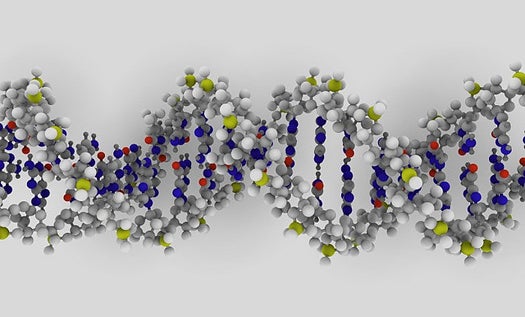The Popular Science Guide To DNA
What is DNA? DNA (deoxyribonucleic acid) is an extremely important molecule for life on Earth. All known living organisms use...

What is DNA?
DNA (deoxyribonucleic acid) is an extremely important molecule for life on Earth. All known living organisms use genetic information in their cell growth and development, division, and function – and DNA is responsible for encoding that information. Structurally, DNA is a double helix (much like a spiral staircase), and each step in the chain is part of a long code that conveys genetic information.
History
The idea that organisms pass on information has been with us for centuries – any look at three generations of humans (grandfather, father, and son, say) will usually demonstrate that, somehow, physical features are hereditary. Also, the theory of evolution assumes that a given generation of a species is a continuation, and perhaps adaptation, from its preceding generations. Yet, for a long time, there weren’t any good explanations of how species inherit traits (Gregor Mendel offering the first, in the 1850s).
DNA was isolated in 1869, and over the next 50 years scientists gradually refined their understanding of the molecule. Around 1930, scientists began to hypothesize that DNA was a carrier of hereditary information. In 1943, Oswald Avery confirmed that hypothesis.
The remaining mystery was the molecule’s precise structure. In 1953, James Watson and Francis Crick were able to identify the double helix structure; 10 years later, they were awarded the Nobel Prize for their discovery. Thus was born the field of molecular biology.
Present
Today, our understanding of DNA enables us to do previously unimaginable things. We can genetically modify organisms by manipulating their DNA – a controversial ability that was anticipated very early on. We can use DNA samples left behind at crime scenes to identify criminals from something as seemingly insignificant as a strand of hair (so long as the hair bulb is attached). Another recent development, the Human Genome Project, attempted to sequence all the DNA in the human cell. The project was completed in 2003. Today, a vast database of sequenced genomes exists (from animals, bacteria, fungi, and more) and allows scientists to quickly compare various species, extract important information (such as genetic relatedness), and learn about mutations and diseases. Also, you can pay to have your own DNA sequenced, which can give you some idea of the diseases you are genetically predisposed to, inform you about your genetic and ancestral history, and more.
Future
In the future, personal DNA sequencing will become even more affordable and easy, though whether it becomes widespread remains to be seen.
Recombinant DNA (sometimes called synthetic biology) refers to the manipulation or creation of DNA sequences. It first came into practice in the 1970s and is a rapidly expanding field. Recombinant DNA has immense potential and could be used to treat genetic diseases and deficiencies, but many people fear its potential negative uses – for instance, in biological warfare – despite the difficulty of creating toxins stronger than those already found in nature.